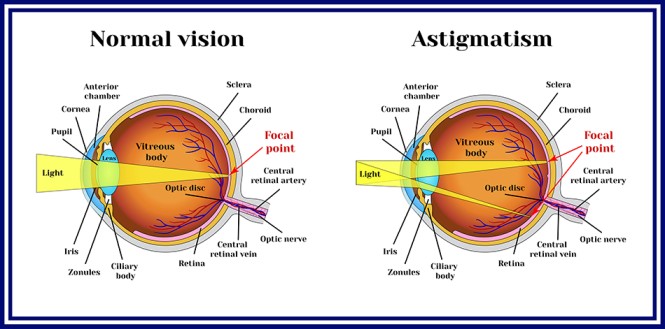Contents
What is astigmatism
Astigmatism is an error developed in the shape of the cornea/lens or just a slight imperfection in its shape. Usually, the shape of the cornea and lens are curved and are spread equally in all directions and they are generally smooth. This greatly helps to converge the light rays hitting the cornea and lens to focus them onto the retina which is located at the back of the eye. If the cornea or lens shape is slightly irregular and isn’t smooth then it will not be bent properly and in doctor’s terms, it’s known as refractive error. This causes people to have blurry, hazy, or distorted vision. Astigmatism varies concerning where it’s affected. If the shape of the cornea is irregular then it is termed “Corneal astigmatism” and if the lens shape is distorted then it is known as “Lenticular astigmatism”.
People suffering from myopia (near-sightedness) or hypermetropia (far-sightedness) can have astigmatism and are very common. Be it “Corneal astigmatism” or “Lenticular astigmatism”, in both cases the vision is distorted and has a wavy appearance and it might pose a problem in people’s normal lifestyle. The shape of the common object gets highly distorted and it may not appear normal, for example, a ground ball may appear ellipsoidal shape or a short object may appear as elongated.
Children affected with astigmatism don’t know that they have astigmatism until they start to experience blurriness in the vision. Astigmatism can be generally hereditary and may affect people from their birth. The condition can decrease or progressively worsen over time. If a person starts to get blurriness or change in the shape of objects in their vision they should immediately get checked with the eye doctor and the doctor may recommend glasses or contact lens which alters the path of light.
Causes of Astigmatism
As previously stated, astigmatism can be related to family genetics or it can also get it after an accident to an eye or after eye disease, or surgery. The cornea/lens is known to bend the path of light which comes into the eye. To focus that ray of light accurately on the retina, the cornea lens has to be smooth and perfect in shape. So, the object can be seen clearly. However, in astigmatism, the shape of the cornea lens is not round and the ray of light doesn’t hit the retina in the required area, so the vision becomes wavy haziness, and blurry. Doctors haven’t exactly tried to find out why the shape of the cornea varies from individual to individual.
Keratoconus, a rare condition can also be the main cause of astigmatism. In this, the cornea becomes thinner and more cone-shaped. This causes astigmatism to worsen over time and people may need contact lenses rather than eyeglasses to see things. Sometimes, they eventually need a corneal transplant.
Symptoms of astigmatism
The symptoms of astigmatism include:
- Haziness or blurriness in the vision
- Strain in the eye
- Frequent headaches
- Difficulty seeing at night
- Squinting while trying to see clearly
- Discomfort in eye
If a person starts having these symptoms, then it may be better if they consult with an ophthalmologist. The eye doctor will do the necessary eye examination to determine if it’s astigmatism or some other condition. The doctor will do an examination called “visual acuity”. In that, he or she will tell you to read certain letters designed for an eye chart. This examination determines the sharpness of your vision.
Tools to determine the measurements for the vision include:
- Keratometer– It is an instrument that measures the curvature of the front surface of the cornea lens. It is also known as Ophthalmometer.
- Phoropter– It is the equipment used to test the lenses individually on each eye during the exam. If a person can see clearly with a particular lens that is determined through a phoropter then that lens is used.
- Autorefractor– During the eye examination, the intensity of light and the change in the path of light in the eye is analyzed and the instrument provides certain measurements of a refractive error of the person’s eye and also gives an idea about the suitable contact lens or eyeglasses.
After doing these tests, the eye doctor analyses all the measurements and determines if the person is suffering from astigmatism or not.
There are certain numbers in your astigmatism measurement reports which are of indeed great significance. Astigmatism is measured in the unit of refractive power called dioptre. A person with perfect vision has 0 diopters while most of the people have diopters in the range of 0.5 to 0.75. If the measurement exceeds 1.5 then he /she may need glasses or contact lenses to see clearly.
The last two of the three numbers in the contact lenses or glasses prescription are referred to as astigmatism. Certain abbreviations are also there which are listed below:
- Spherical (SPH) – It tells us about the amount of power of the lens, measured in diopters. A positive (+) sign indicated far-sightedness and a negative (-) sign indicates nearsightedness.
- Cylinder (CYL) – It indicates the amount degree of astigmatism a person is suffering from. If the measurement below this column is empty then the person has no astigmatism or has slight astigmatism which doesn’t involve the use of lenses or glasses.
- Axis – It represents the amount of angle at which the cylindrical section is placed in your contact lenses. The axis number ranges from 1 to 180.
Treatment for astigmatism

Commonly, eyeglasses and contact lenses are known to correct the causes of astigmatism. For some cases, some treatments are required which include:
Orthokeratology
Orthokeratology is also known as Corneal refractive therapy/ Ortho-K or Overnight vision correction. It involves the use of a series of contact lenses which eventually reshapes the cornea. The overnight term comes because the person is suggested to wear contact lenses temporarily, like overnight, and then is advised to remove them in the morning. Ortho-K doesn’t correct the vision permanently. If the person stops using the contact lens then his/her vision may return to its previous/distorted state.
LASIK and PRK Surgery
LASIK Surgery (Laser in situ keratomileuses) is a surgery to correct the shape of the cornea which involves removing a thin layer of tissue from the inner side of the cornea. PRK (Photorefractive keratectomy) is a type of laser-involved surgery in which the eye surgeon removes the tissue from the top layer of the cornea, called the epithelium, and in turn corrects the shape and curvature.
Your eye doctor will recommend what’s the best-suited treatment for your condition and he/she will discuss the available surgery options with you.
We also offer various services like Retina Surgery, Specs Removal, Lasik Surgery, Squint, Cataract Surgery, Glaucoma Surgery, and much more.



